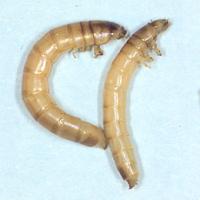Diagnosing vegetable beetle damage
A widespread beetle is mainly a pest of summer crops, but has seriously damaged young canola in southern districts, especially when there has been a warm start to the growing season. Vegetable beetles are not to be confused with vegetable weevils that have a long snout.
What to look for
- Patches of dead and chewed seedling to 5 leaf canola plants.
- Areas near rock heaps or with heavier stubble or previous pasture residues may be more affected.
- As the beetles are most active above 15 °C, early sown paddocks will be more affected.
Paddock
- Plants dead and ringbarked or chewed crown, stem or petiole.
Plant
- Oval 8 millimetres (mm) long beetles with a rounded head and flattened body. They are usually a dull grey colour, but may appear brown or almost black.
- Vegetable beetles are not to be confused with vegetable weevils that have a long snout.
- They generally hide under rocks and plant residues during the day but may come out to feed in warm weather. They are easily found in close proximity to damaged plants.
- Beetle larvae (yellow shiny hard shelled false wireworms), may be present just beneath the soil surface, but rarely damage canola.
Insect Adult
What else could it be
| Condition | Similarities | Differences |
|---|---|---|
| Diagnosing false wireworm | Stem ringbarked, sudden plant death | Vegetable beetle also chews leaves and petioles, beetle shape |
| Diagnosing blackleg in canola | Sudden seedling death | Blackleg lesions on plants. Lack of insects or chewing damage |
Management strategies
- Vegetable beetles tolerate high insecticide rates, and there are currently none registered for their control.
- Main risk factors are: Southern district crops, high amounts of retained stubble and early sown crops when temperatures are above 15°C.
- Beetle numbers can be decreased by reducing shelter such as stubble or rocky out-crops under which beetles can survive the summer.
- Increased seeding rate helps maintain plant density in high risk years, or if reseeding is required.
How can it be monitored?
- Monitor canola crops for damage from seeding, especially if there is a warm start to the season.
Page last updated: Wednesday, 6 May 2015 - 11:45am




